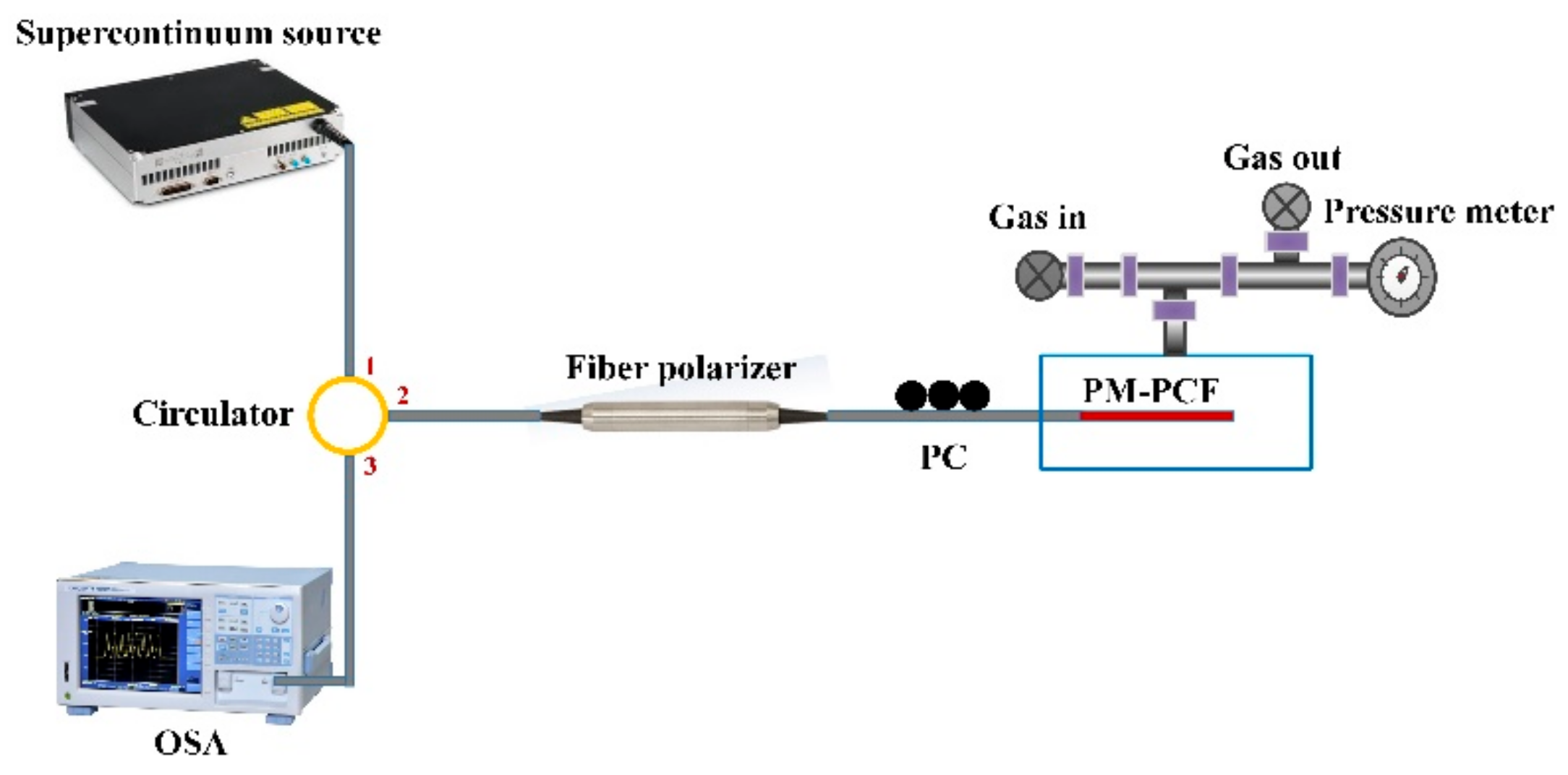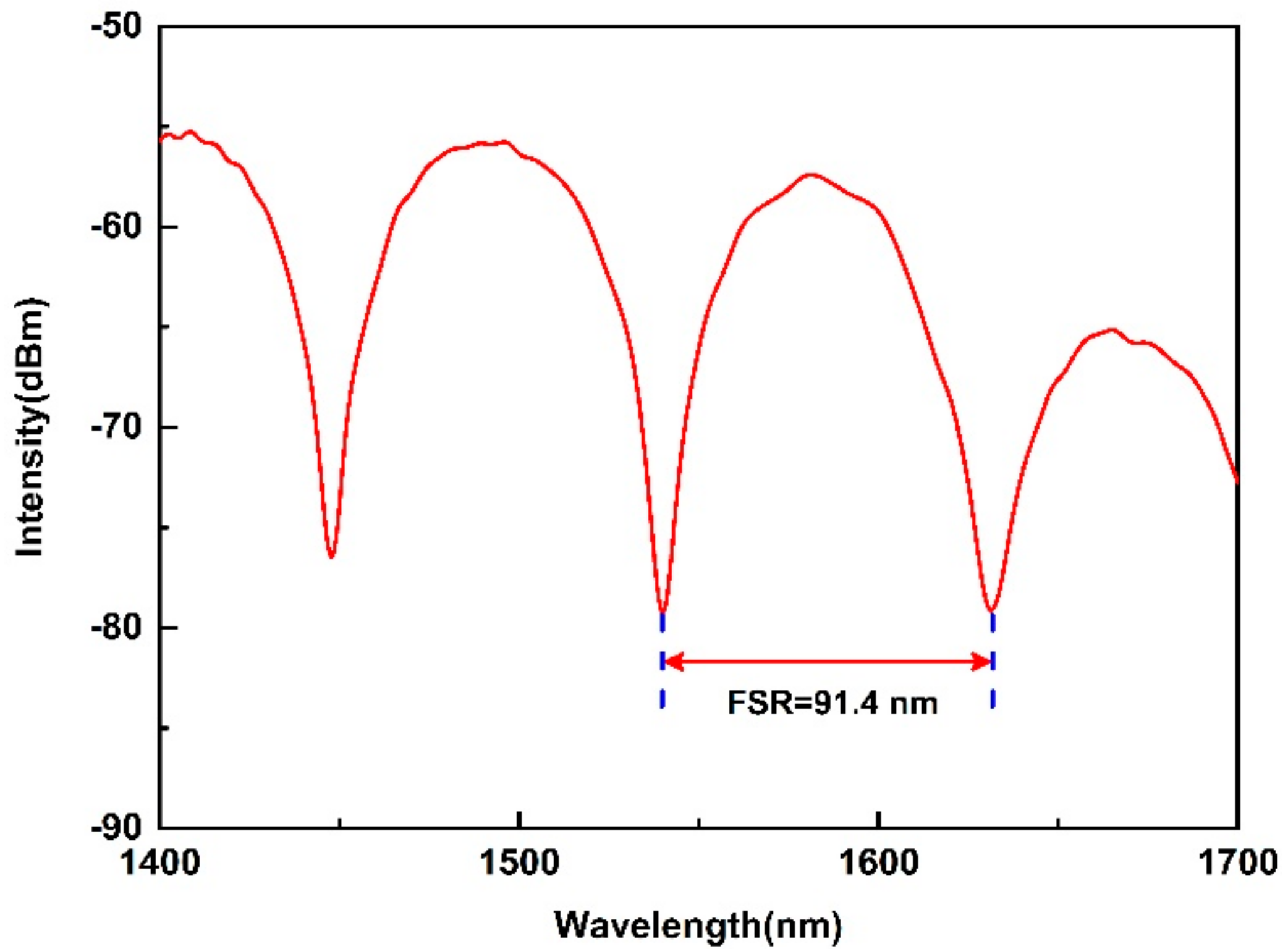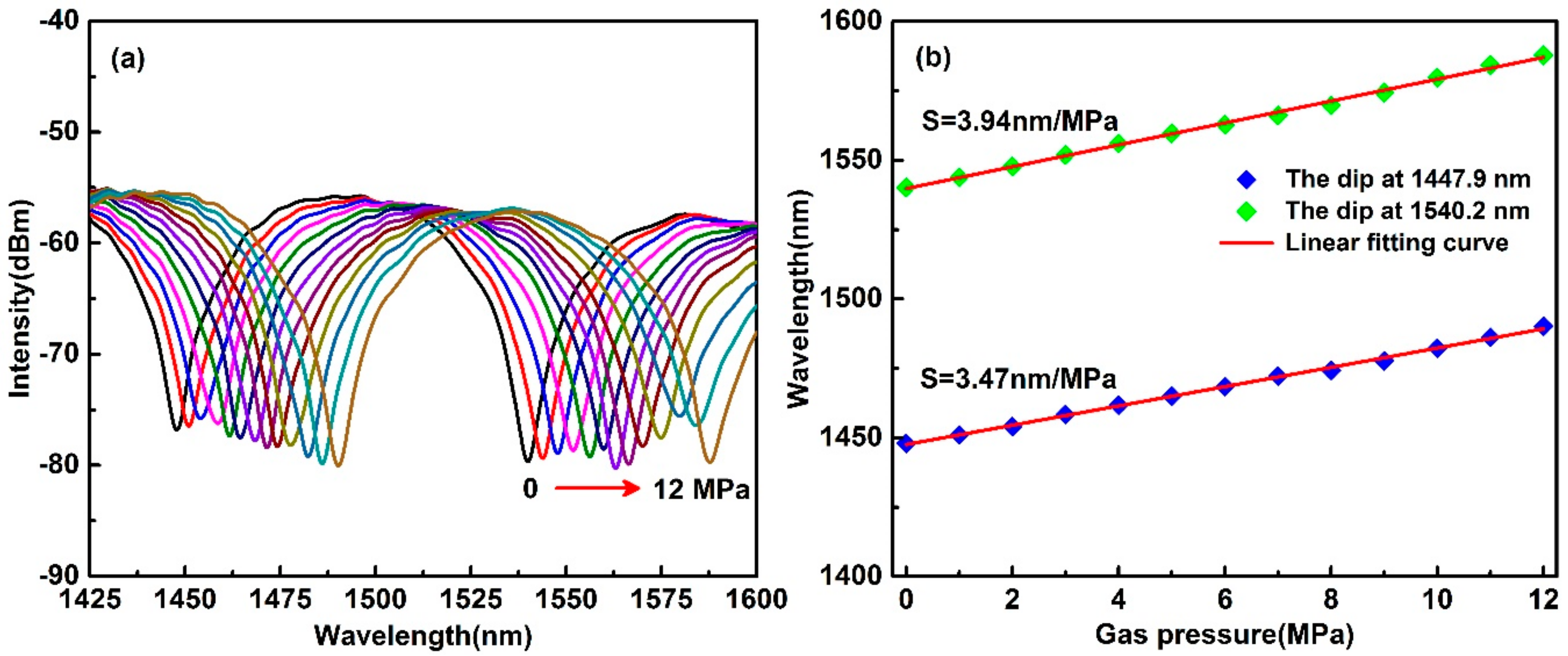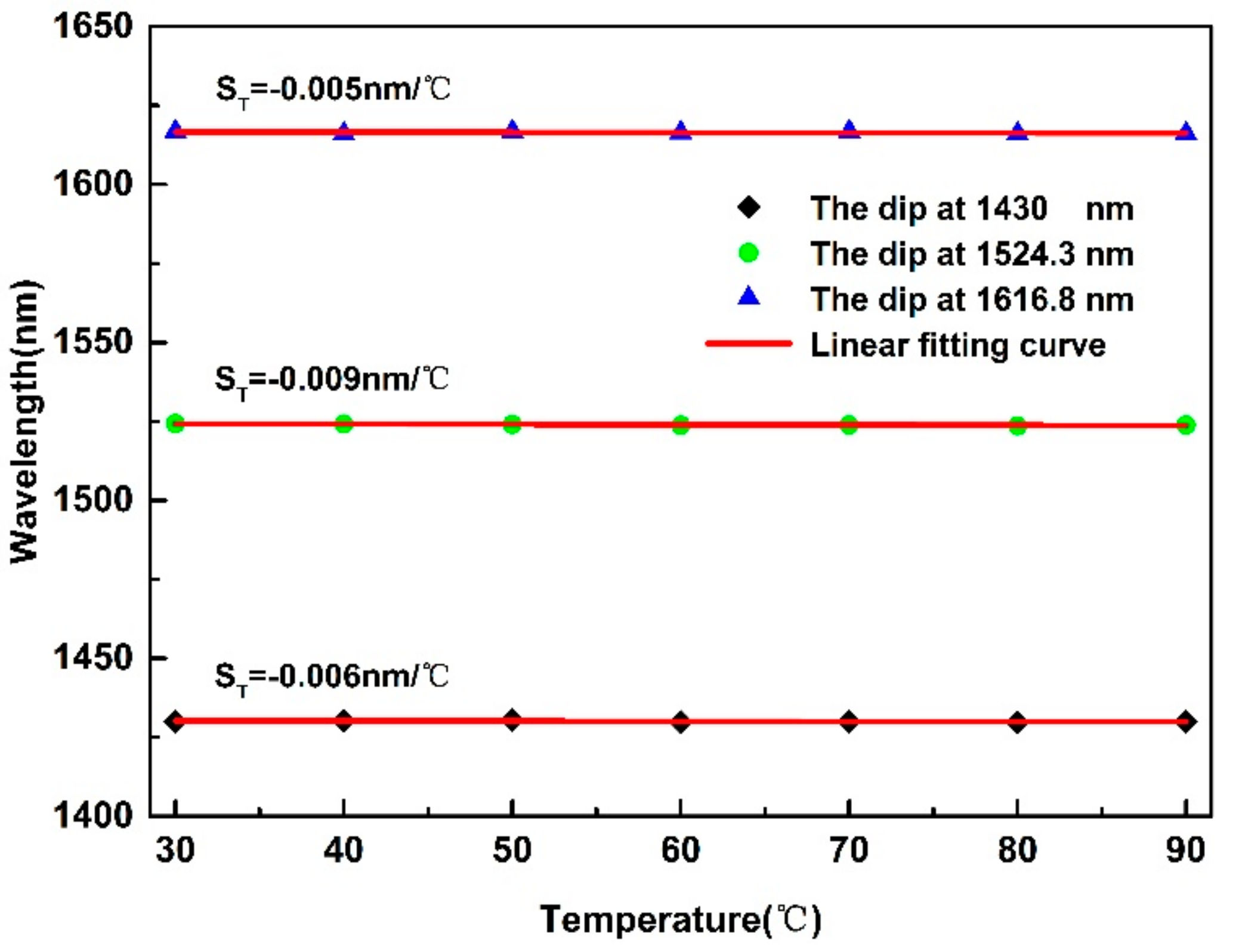Temperature-Independent Gas Pressure Sensor with High Birefringence Photonic Crystal Fiber-Based Reflective Lyot Filter
Abstract
1. Introduction
2. Device Fabrication and Working Principle
3. Experiment Research
4. Conclusions
Author Contributions
Funding
Conflicts of Interest
References
- Zhong, X.Y.; Wang, Y.P.; Liao, C.R.; Liu, S.; Tang, J.; Wang, Q. Temperature-insensitivity gas pressure sensor based on inflated long period fiber grating inscribed in photonic crystal fiber. Opt. Lett. 2015, 40, 1791–1794. [Google Scholar] [CrossRef] [PubMed]
- Tang, J.; Zhang, Z.; Yin, G.; Liu, S.; Bai, Z.; Li, Z.; Deng, M.; Wang, Y.; Liao, C.; He, J.; et al. Long period fiber grating inscribed in hollow-core photonic bandgap fiber for gas pressure sensing. IEEE Photonics J. 2017, 9, 1–7. [Google Scholar] [CrossRef]
- Tang, D.; Yang, D.; Jiang, Y.; Zhao, J.; Wang, H.; Jiang, S. Fiber loop ring-down optical fiber grating gas pressure sensor. Opt. Lasers Eng. 2010, 48, 1262–1265. [Google Scholar] [CrossRef]
- Li, Z.; Liao, C.; Wang, Y.; Xu, L.; Wang, D.; Dong, X.; Liu, S.; Wang, Q.; Yang, K.; Zhou, J. Highly-sensitive gas pressure sensor using twin-core fiber based in-line Mach-Zehnder interferometer. Opt. Express 2015, 23, 6673–6678. [Google Scholar] [CrossRef]
- Talataisong, W.; Wang, D.N.; Chitaree, R.; Liao, C.R.; Wang, C. Fiber in-line Mach–Zehnder interferometer based on an inner air-cavity for high-pressure sensing. Opt. Lett. 2015, 40, 1220–1222. [Google Scholar] [CrossRef]
- Lin, H.; Liu, F.; Guo, H.; Zhou, A.; Dai, Y. Ultra-highly sensitive gas pressure sensor based on dual side-hole fiber interferometers with Vernier effect. Opt. Express 2018, 26, 28763–28772. [Google Scholar] [CrossRef]
- Mao, C.; Huang, B.; Wang, Y.; Huang, Y.; Zhang, L.; Shao, Y.; Wang, Y. High-sensitivity gas pressure sensor based on hollow-core photonic bandgap fiber Mach-Zehnder interferometer. Opt. Express 2018, 26, 30108–30115. [Google Scholar] [CrossRef]
- Wang, Y.; Wang, D.N.; Wang, C.; Hu, T. Compressible fiber optic micro-Fabry-Pérot cavity with ultra-high pressure sensitivity. Opt. Express 2013, 21, 14084–14089. [Google Scholar] [CrossRef]
- Xu, B.; Wang, C.; Wang, D.N.; Liu, Y.; Li, Y. Fiber-tip gas pressure sensor based on dual capillaries. Opt. Express 2015, 23, 23484–23492. [Google Scholar] [CrossRef]
- Zhang, Z.; He, J.; Dong, Q.; Bai, Z.; Liao, C.; Wang, Y.; Liu, S.; Guo, K.; Wang, Y. Diaphragm-free gas-pressure sensor probe based on hollow-core photonic bandgap fiber. Opt. Lett. 2018, 43, 3017–3020. [Google Scholar] [CrossRef]
- Donlagic, D.; Cibula, E. All-fiber high-sensitivity pressure sensor with SiO2 diaphragm. Opt. Lett. 2005, 30, 2071–2073. [Google Scholar] [CrossRef] [PubMed]
- Ma, J.; Ju, J.; Jin, L.; Jin, W. A compact fiber-tip micro-cavity sensor for high-pressure measurement. IEEE Photonics Technol. Lett. 2011, 23, 1561–1563. [Google Scholar] [CrossRef]
- Liao, C.; Liu, S.; Xu, L.; Wang, C.; Wang, Y.; Li, Z.; Wang, Q.; Wang, D.N. Sub-micron silica diaphragm-based fiber-tip Fabry–Perot interferometer for pressure measurement. Opt. Lett. 2014, 39, 2827–2830. [Google Scholar] [CrossRef] [PubMed]
- Ma, J.; Jin, W.; Ho, H.L.; Dai, J.Y. High-sensitivity fiber-tip pressure sensor with graphene diaphragm. Opt. Lett. 2012, 37, 2493–2495. [Google Scholar] [CrossRef]
- Guo, F.; Fink, T.; Han, M.; Koester, L.; Turner, J.; Huang, J. High-sensitivity, high-frequency extrinsic Fabry–Perot interferometric fiber-tip sensor based on a thin silver diaphragm. Opt. Lett. 2012, 37, 1505–1507. [Google Scholar] [CrossRef]
- Cheng, L.; Wang, C.; Huang, Y.; Liang, H.; Guan, B.O. Silk fibroin diaphragm-based fiber-tip Fabry-Perot pressure sensor. Opt. Express 2016, 24, 19600–19606. [Google Scholar] [CrossRef]
- Chen, C.Y.; Pan, C.L.; Hsieh, C.F.; Lin, Y.F.; Pan, R.P. Liquid-crystal-based terahertz tunable Lyot filter. Appl. Phys. Lett. 2006, 88, 101107. [Google Scholar] [CrossRef]
- Gorman, A.; Fletcher-Holmes, D.W.; Harvey, A.R. Generalization of the Lyot filter and its application to snapshot spectral imaging. Opt. Express 2010, 18, 5602–5608. [Google Scholar] [CrossRef]
- O’Riordan, C.; Connelly, M.J.; Anandarajah, P.M.; Maher, R.; Barry, L.P. Lyot filter based multiwavelength fiber ring laser actively mode-locked at 10 GHz using an electroabsorption modulator. Opt. Commun. 2008, 281, 3538–3541. [Google Scholar] [CrossRef]
- Zoiros, K.E.; O’Riordan, C.; Connelly, M.J. Semiconductor optical amplifier pattern effect suppression using Lyot filter. Electron. Lett. 2009, 45, 1187–1189. [Google Scholar] [CrossRef]
- Ge, J.; Feng, H.; Scott, G.; Fok, M.P. High-speed tunable microwave photonic notch filter based on phase modulator incorporated Lyot filter. Opt. Lett. 2015, 40, 48–51. [Google Scholar] [CrossRef] [PubMed]
- Yan, Z.; Wang, H.; Zhou, K.; Wang, Y.; Zhao, W.; Zhang, L. Broadband Tunable All-Fiber Polarization Interference Filter Based on 45° Tilted Fiber Gratings. IEEE J. Lightwave Technol. 2012, 31, 94–98. [Google Scholar] [CrossRef]
- Huang, B.; Shu, X.; Du, Y. Intensity modulated torsion sensor based on optical fiber reflective Lyot filter. Opt. Express 2017, 25, 5081–5090. [Google Scholar] [CrossRef] [PubMed]
- Huang, B.; Shu, X. Highly sensitive twist sensor based on temperature-and strain-independent fiber Lyot filter. IEEE J. Lightwave Technol. 2017, 35, 2026–2031. [Google Scholar] [CrossRef]
- Huang, B.; Ying, W.; Mao, C.; Wang, Y. Temperature-and strain-insensitive transverse load sensing based on optical fiber reflective Lyot filter. Appl. Phys. Express 2019, 12, 076501. [Google Scholar] [CrossRef]
- Malka, D.; Cohen, E.; Zalevsky, Z. Design of 4 × 1 power beam combiner based on multicore photonic crystal fiber. Appl. Sci. 2017, 7, 695. [Google Scholar] [CrossRef]
- Malka, D.; Sintov, Y.; Zalevsky, Z. Fiber-laser monolithic coherent beam combiner based on multicore photonic crystal fiber. Opt. Eng. 2014, 54, 011007. [Google Scholar] [CrossRef]
- Sintov, Y.; Malka, D.; Zalevsky, Z. Prospects for diode-pumped alkali-atom-based hollow-core photonic-crystal fiber lasers. Opt. Lett. 2014, 39, 4655–4658. [Google Scholar] [CrossRef]
- Liu, Q.; Li, S.G.; Chen, H. Enhanced sensitivity of temperature sensor by a PCF with a defect core based on Sagnac interferometer. Sens. Actuators B 2018, 254, 636–641. [Google Scholar] [CrossRef]
- Ortigosa-Blanch, A.; Knight, J.C.; Wadsworth, W.J.; Arriaga, J.; Mangan, B.J.; Birks, T.A.; Russell, P.S.J. Highly birefringent photonic crystal fibers. Opt. Lett. 2000, 25, 1325–1327. [Google Scholar] [CrossRef]
- Moon, D.S.; Kim, B.H.; Lin, A.; Sun, G.; Han, Y.G.; Han, W.T.; Chung, Y. The temperature sensitivity of Sagnac loop interferometer based on polarization maintaining side-hole fiber. Opt. Express 2007, 15, 7962–7967. [Google Scholar] [CrossRef] [PubMed]
- Zhang, J.; Qiao, X.; Guo, T.; Weng, Y.; Wang, R.; Ma, Y.; Rong, Q.Z.; Hu, M.L.; Feng, Z. Highly sensitive temperature sensor using PANDA fiber Sagnac interferometer. J. Lightwave Technol. 2011, 29, 3640–3644. [Google Scholar] [CrossRef]
- Wang, X.; Yang, H.J.; Wang, S.S.; Liao, Y.P.; Wang, J. Seawater temperature measurement based on a high-birefringence elliptic fiber Sagnac loop. IEEE Photonics Technol. Lett. 2015, 27, 1772–1775. [Google Scholar] [CrossRef]
- Domínguez-Cruz, R.; May-Arrioja, D.A.; Martínez-Manuel, R.; Lopez-Cortes, D. Temperature Sensor Based on an Asymmetric Two-Hole Fiber Using a Sagnac Interferometer. J. Sens. 2018, 2018, 7595106. [Google Scholar] [CrossRef]
- Dong, B.; Hao, J.; Liaw, C.Y.; Xu, Z. Cladding-mode resonance in polarization-maintaining photonic-crystal-fiber-based sagnac interferometer and its application for fiber sensor. J. Lightwave Technol. 2011, 29, 1759–1763. [Google Scholar] [CrossRef]





| Fiber Type | Temperature Sensitivity |
|---|---|
| Polarization maintaining side-hole fiber [31] | 140 pm/°C |
| PANDA fiber [32] | −1.46 nm/°C |
| High-birefringence elliptic fiber [33] | −472 pm/°C |
| Asymmetric two-hole fiber [34] | 2.22 nm/°C |
| Polarization maintaining PCF [35] | 4.1 pm/°C |
| HB-PCF in our work | −9 pm/°C |
© 2019 by the authors. Licensee MDPI, Basel, Switzerland. This article is an open access article distributed under the terms and conditions of the Creative Commons Attribution (CC BY) license (http://creativecommons.org/licenses/by/4.0/).
Share and Cite
Huang, B.; Wang, Y.; Mao, C. Temperature-Independent Gas Pressure Sensor with High Birefringence Photonic Crystal Fiber-Based Reflective Lyot Filter. Sensors 2019, 19, 5312. https://doi.org/10.3390/s19235312
Huang B, Wang Y, Mao C. Temperature-Independent Gas Pressure Sensor with High Birefringence Photonic Crystal Fiber-Based Reflective Lyot Filter. Sensors. 2019; 19(23):5312. https://doi.org/10.3390/s19235312
Chicago/Turabian StyleHuang, Bo, Ying Wang, and Chun Mao. 2019. "Temperature-Independent Gas Pressure Sensor with High Birefringence Photonic Crystal Fiber-Based Reflective Lyot Filter" Sensors 19, no. 23: 5312. https://doi.org/10.3390/s19235312
APA StyleHuang, B., Wang, Y., & Mao, C. (2019). Temperature-Independent Gas Pressure Sensor with High Birefringence Photonic Crystal Fiber-Based Reflective Lyot Filter. Sensors, 19(23), 5312. https://doi.org/10.3390/s19235312




